Wrapping Up
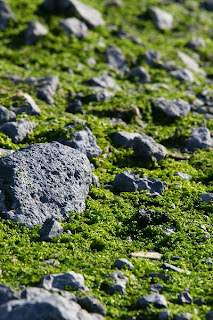
Verdant Crozier: a lush mat of snow algae, the only green growing thing around.
Our season is coming to a close. After I wrote about the last storm we had a week of gorgeous weather - blue sky, the ocean so flat you could see whales breaking its silvery surface 3 miles offshore. After several days in the hut we had a lot to catch up on, and very little time for anything but field work, food, and the usual sound sleep (thus the paucity of journal entires). We retrieved the last of our transmitters, found two more GLS tags, searched for the few banded birds remaining in the colony, determined nest fates, counted and measured chicks, and the final big two: sledge-hauling and chick banding.The hauling involves packing about 350 lbs of weighbridge gear onto a banana sled, tying sled ropes to the backs of our packs, pulling on our crampons, and slowly working our way up the icy, sastrugi-ridden snow slope to the hut, which sits at 870 feet above sea level at the foot of Mt. Terror. This year it was just me, Grant, and Kirsten, my first time in six seasons doing this with just three humans. Packing up the weighbridge gear takes a few hours. The hauling is a 45-minute ordeal that always reminds me of how easy we have it compared to Antarctica's early explorers, who did this every day up and down glaciers and across ice shelves in the most formidable weather. Fortunately for us the weather was calm and overcast, which saved us from overheating.The next day we headed back to the colony with the chick corral and banded 1,000 penguin chicks - the newest cohort of known-age birds to join the study. We found the largest chicks and fitted them with metal bands around the left flipper. The banding took about six hours and gave us sore thumbs for two days. If the chicks make it past the leopard seals just off the beach and survive the vagaries of their first years at sea they will come back in 4-5 years to learn the social skills necessary for life in the colony: how to build a nest, defend a territory, distinguish between a potential mate and an intruder, copulate, hatch an egg, feed a chick. The trials are multiple, and some penguins never get it right - they are too aggressive and chase away anything that moves (including young flirts), or too meek and have trouble defending a territory against the more assertive birds. Other birds start breeding at a young age and always have a nice nest, big chicks, and a seasoned mate. Yet others seem to prefer endless copulation over the responsibilities of parenthood. We've seen perpetual loners, lasting couples, serial monogamists, and threesomes, and considering how similar males and females look it's impossible to rule out other combinations.The following day we packed up and cleaned the hut in preparation for leaving. But on packing day it began snowing, and the snow always bodes a storm. It snowed into the next day so our helicopter to McMurdo was canceled. That was yesterday. This morning it was calm here but apparently not at McMurdo, so still no helicopter. In the afternoon the much-awaited wind arrived and is now at a galloping 60-70 mph. The pallid sky has disappeared behind a thick curtain of blowing snow, which fills every gap, chokes every orifice, and saturates the air with moisture. Our work is done, our tents are packed, and half our gear is on the helicopter pad, so all we can do is wait. We're down to canned food (no more pork tenderloin!), though fortunately we still have a good supply of dark chocolate, which is the most important food item in Antarctica.But enough about the weather, which is stealing all the attention this season. Here are some recent favorite photos of Adelie penguins, (arguably) the most amazing birds in Antarctica.In the colony:
Bird with a satellite tag on its back, back at his nest after a trip at sea. I watched him feed fish to his chicks for a while before retrieving the tag.
A very tired penguin.
Punk looks, dorky attitude. A molting chick sees its first human.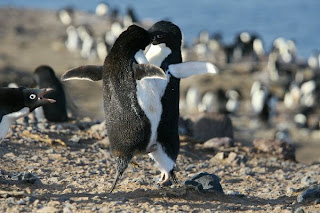
Two Adelies settle a dispute.
Adelies come and go along the Penguin Superhighway.At the water's edge: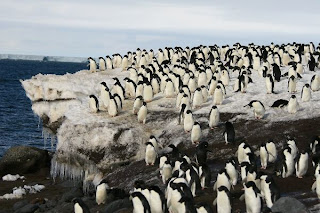
Adelies waiting at the water's edge. There was a leopard seal near the beach that day, so no one was volunteering to be first.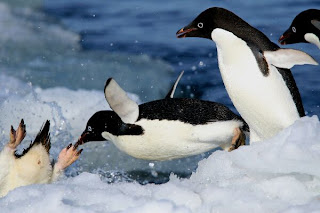

When there is no leopard seal everyone jumps in at once.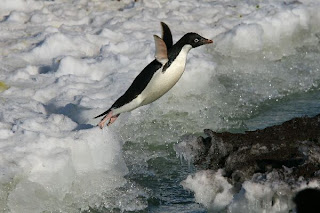
Jumping over a crack.
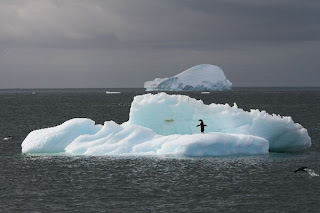
Standing on a floe.
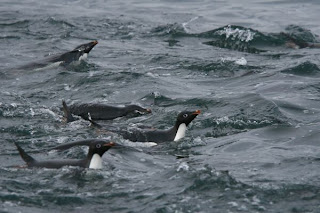
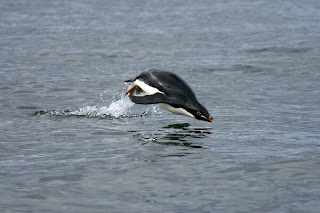
Porpoising, a penguin's fastest mode of travel.Penguins and mountains: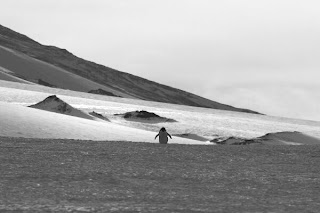
A lone penguin on the snow slope above the colony.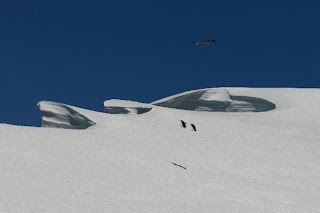
Two explorers climb the cornice while a skua flies overhead.
Stormy, Again
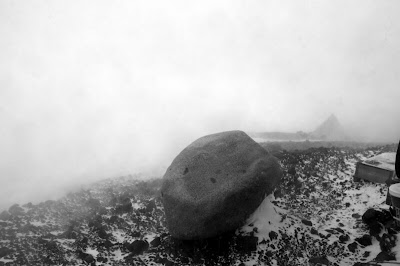 View from the hut door, Kirsten's Scott tent barely visible through the white-outThis time it's a real one. Storm force winds (64-72 mph), blowing snow, zero visibility. It's been difficult to count storms this season because they come one right after the other. Front after front we've been getting pounded with gales, storms, and snow. We take weather observations twice a day, and the wind speed for the past month has been oscillating up and down like a restless animal. If you've been on this side of Antarctica this year chances are you've heard it too: it's one of the worst weather years anyone can remember. Flights to the continent have been delayed. Helicopters have been grounded. And no matter how windy it is elsewhere, Cape Crozier lives up to its reputation by always being a little bit windier. It's a hard place to get to - it's always a good idea to include several days of likely weather delays in any Crozier plan. Unless, however, you are Chris Linder and Hugh Powell, you are willing to dare history, and you try to fly from Cape Crozier to Christchurch in one day, skipping the McMurdo rigmarole altogether, which they did on December 27th. They left Crozier at 8:30 AM and by midnight they were on the dark streets of Christchurch, calling us to find out where they could get some food.
View from the hut door, Kirsten's Scott tent barely visible through the white-outThis time it's a real one. Storm force winds (64-72 mph), blowing snow, zero visibility. It's been difficult to count storms this season because they come one right after the other. Front after front we've been getting pounded with gales, storms, and snow. We take weather observations twice a day, and the wind speed for the past month has been oscillating up and down like a restless animal. If you've been on this side of Antarctica this year chances are you've heard it too: it's one of the worst weather years anyone can remember. Flights to the continent have been delayed. Helicopters have been grounded. And no matter how windy it is elsewhere, Cape Crozier lives up to its reputation by always being a little bit windier. It's a hard place to get to - it's always a good idea to include several days of likely weather delays in any Crozier plan. Unless, however, you are Chris Linder and Hugh Powell, you are willing to dare history, and you try to fly from Cape Crozier to Christchurch in one day, skipping the McMurdo rigmarole altogether, which they did on December 27th. They left Crozier at 8:30 AM and by midnight they were on the dark streets of Christchurch, calling us to find out where they could get some food. Kirsten braves the white-out to go check on her tent, then decides against itWe walk constantly at Crozier. The history of our tracks is constantly being written and rewritten on the long snow slope between the hut and the colony. Somtimes we see the eroded human or penguin tracks from a previous year compressed and shaped into raised lumps carved by the wind until they are recognizable as footsteps only by their pattern and regularity: humans have a long gait, penguins have a short, narrow gait. Fresh snow erases everything. It conceals old tracks and then reveals the new ones after a new blanket is laid. Footsteps don't lie - you can tell where everyone has walked, where they stopped and stood around, where they rubbed guano off their clothes with fresh snow (aka the "Crozier shower"), and where they wiped out over a slab of blue ice lurking beneath the fluffy stuff. You can tell where a wandering band of penguins has come up the hill, inspecting our camp while we are not here (what are those humans up to???). But wind doesn't like snow, we've decided, and after a big snow the wind always comes to scrape everything back down to blue ice.The hardest part about storms is being hut-bound. No walking. I love walking on uneven terrain - it requires a lot of mindfulness. Here I'm reminded how little I have to think about where to place my feet in the "other world" - on city streets and groomed trails. We humans animals are no longer connected to the ground we walk on, and are now free to gape at shop windows and chat on cell phones instead. But here I must negotiate different kinds of snow, ice, big rocks, little rocks, orange lichens growing in the lee of hummocks (not to be stepped on), sleeping penguins (not to be disturbed). How slippery is that snow surface? Will that rock move? If I become distracted I will fall.Penguins do fine in the wind. They don't tumble until the wind speeds go above 130 or 140 mph, we think, though given our own considerable disadvantage in such conditions it's difficult to evaluate just where that penguin/wind threshold is...
Kirsten braves the white-out to go check on her tent, then decides against itWe walk constantly at Crozier. The history of our tracks is constantly being written and rewritten on the long snow slope between the hut and the colony. Somtimes we see the eroded human or penguin tracks from a previous year compressed and shaped into raised lumps carved by the wind until they are recognizable as footsteps only by their pattern and regularity: humans have a long gait, penguins have a short, narrow gait. Fresh snow erases everything. It conceals old tracks and then reveals the new ones after a new blanket is laid. Footsteps don't lie - you can tell where everyone has walked, where they stopped and stood around, where they rubbed guano off their clothes with fresh snow (aka the "Crozier shower"), and where they wiped out over a slab of blue ice lurking beneath the fluffy stuff. You can tell where a wandering band of penguins has come up the hill, inspecting our camp while we are not here (what are those humans up to???). But wind doesn't like snow, we've decided, and after a big snow the wind always comes to scrape everything back down to blue ice.The hardest part about storms is being hut-bound. No walking. I love walking on uneven terrain - it requires a lot of mindfulness. Here I'm reminded how little I have to think about where to place my feet in the "other world" - on city streets and groomed trails. We humans animals are no longer connected to the ground we walk on, and are now free to gape at shop windows and chat on cell phones instead. But here I must negotiate different kinds of snow, ice, big rocks, little rocks, orange lichens growing in the lee of hummocks (not to be stepped on), sleeping penguins (not to be disturbed). How slippery is that snow surface? Will that rock move? If I become distracted I will fall.Penguins do fine in the wind. They don't tumble until the wind speeds go above 130 or 140 mph, we think, though given our own considerable disadvantage in such conditions it's difficult to evaluate just where that penguin/wind threshold is...
Old, raised penguin tracks; recent, sunken penguin tracks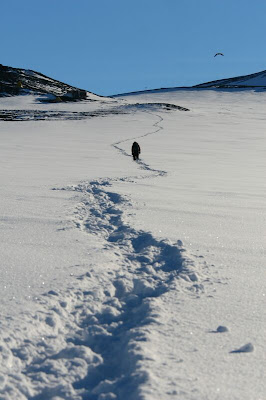 Grant retracing the morning's fresh track
Grant retracing the morning's fresh track
More on Leopold
OK, you ask, how do we know it's Leopold again? So far only one has been positively identified as having been here both years, and it happens to be Leopold. I had an inkling when I saw him on December 29th - that look in his eyes, the way he came over to inspect us and then lost interest, the way he lost three penguins in a row before making a successful kill. Leopold was curious, and he was never that good at catching penguins. Definitely not as good as the huge seal we watched kill 11 in a row on Jan. 7th last year (we didn't name him - he was mean, his fat head was clearly nurtured by penguin blubber and his eyes were dark, unempathetic wells). Seals have style, and Leopold is clumsy, inquisitive, and even a little charming. OK, I may be anthropomorphizing here, but I had a definite feeling of familiarity when he looked us in the eye from beneath the ice foot.Then Kirsten had the bright idea of comparing leopard seal headshots from the past two years. They all have unique face markings. She and Grant carefully combed through all the photos and decided that the one we called Leopold last year was indeed seen again on December 29th. He has a scar (or dimple) on the left cheek just above the edge of his lips and a circle of 8-9 dots on his lower left cheek, just below and past the edge of the mouth, with three dots in the middle. His right cheek is mostly clear of dots. Not to mention that slightly derisive smile on his face.Here are the photos to prove it, last year (left) and this year (right). Click on the image to enlarge.


















